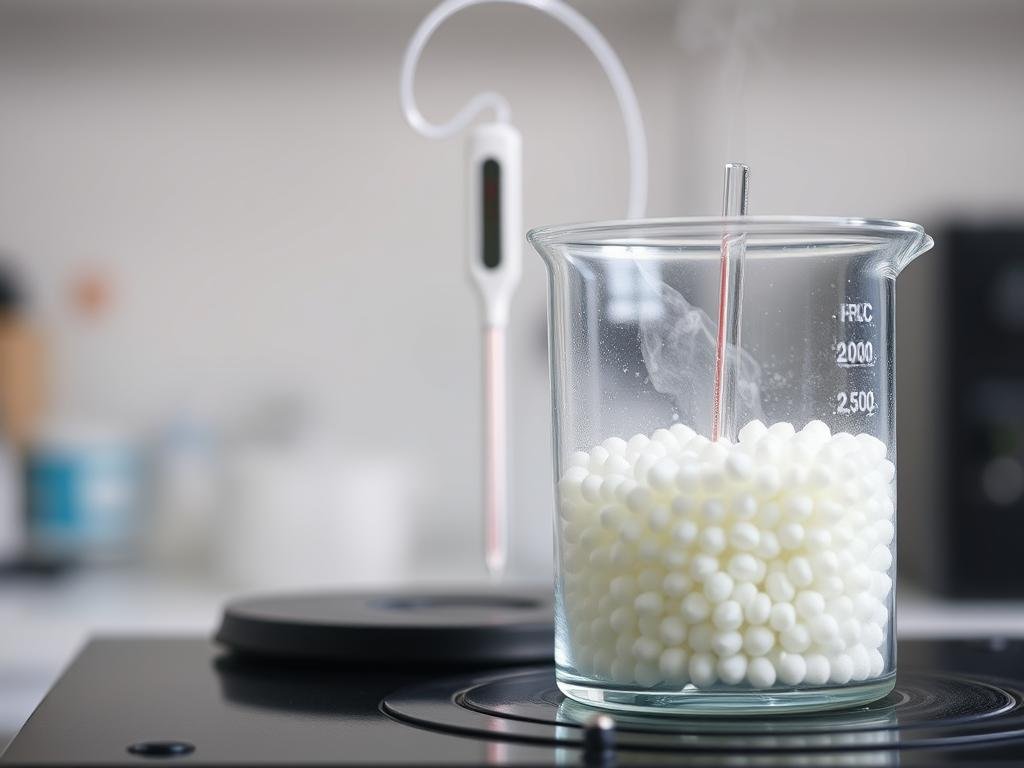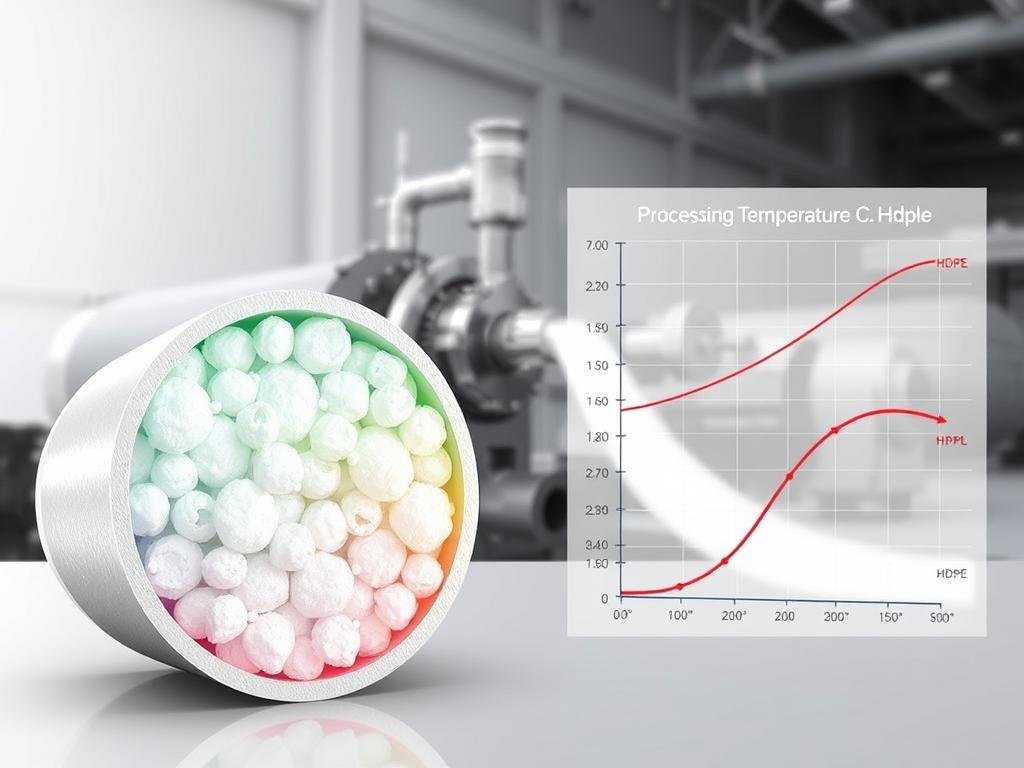High-Density Polyethylene (HDPE) is a versatile plastic material known for its high crystallinity and unique thermal properties. The 熔點 HDPE的熔點,通常約在135°C(275°F)左右,是一個影響其應用的重要特性。
The temperature at which HDPE transitions from a solid to a liquid state is significant for both processing and end-use applications. Understanding this property is essential for manufacturers and engineers working with HDPE.
HDPE的分子結構,以較低比例的側支鏈為特徵,促進其熱性質,成為多個產業中具有價值的材料。
了解高密度聚乙烯(HDPE)
With its high density and specific molecular arrangement, HDPE exhibits a range of characteristics that make it highly valuable in various applications. Its unique structure grants it superior 屬性 that are not commonly found in other types of polyethylene.
什麼使 HDPE 不同
HDPE is distinct from other polyethylenes due to its high density and minimal branching, which results in stronger intermolecular forces. This characteristic enhances its 力量 和 抗拒 to various environmental factors.
關鍵物理性質
HDPE boasts several key physical properties that contribute to its widespread use. Some of its notable attributes include:
- High tensile 力量 (15.2-45 MPa), ideal for load-bearing applications.
- Outstanding chemical 抗拒, particularly to acids and bases.
- A Shore D hardness of 55-69, providing good rigidity and impact 抗拒.
- Low water absorption rate, contributing to its dimensional stability.
| Property | Value | 好處 |
|---|---|---|
| 拉伸強度 | 15.2-45 MPa | Load-bearing capacity |
| Chemical Resistance | 高 | Durable in harsh environments |
| Shore D Hardness | 55-69 | Rigidity and impact resistance |
The combination of these properties makes HDPE a versatile material with excellent performance in a wide range of applications, from piping systems to packaging materials.
The HDPE Melting Point: A Closer Look
To fully leverage HDPE’s potential, it’s necessary to examine its melting point in detail. The melting point is a critical property that determines the suitability of HDPE for various applications.
Typical Melting Range: 120°C to 180°C
The melting point of HDPE typically ranges between 120°C to 180°C. This range is influenced by the material’s molecular structure and crystallinity. The specific melting point within this range can vary based on the HDPE grade and production process.
| Property | Typical Value | 單位 |
|---|---|---|
| Melting Point Range | 120 – 180 | °C |
| 結晶性 | 60 – 80 | % |
| Molecular Weight | Varied | g/mol |
How Melting Point is Measured
The melting point of HDPE is typically measured using Differential Scanning Calorimetry (DSC), a thermal analysis technique that tracks heat flow during phase transitions. 
- DSC testing involves heating a small sample of HDPE at a controlled rate alongside a reference material, and recording the difference in heat flow.
- The melting point is identified on the resulting thermogram as an endothermic peak, representing the temperature at which the crystalline regions of the polymer absorb heat to transition from solid to liquid state.
- Standardized test methods, such as ASTM D3418, are used to ensure accurate and consistent measurement of the melting point.
This precise measurement is essential for quality control in manufacturing and for ensuring that HDPE materials meet specific thermal performance requirements.
Factors Affecting HDPE’s Thermal Properties
Understanding the factors that affect HDPE’s thermal properties is essential for optimizing its performance in various applications. Several factors play a crucial role in determining HDPE’s thermal behavior.
Molecular Weight and Structure
The molecular weight and structure of HDPE significantly influence its melting point and thermal stability. Higher molecular weight HDPE tends to have a higher melting point due to its larger molecular size and stronger intermolecular forces.
Crystallinity and Its Impact
Crystallinity is another critical factor affecting HDPE’s thermal properties. Higher crystallinity levels result in a higher melting point because the crystalline regions are more stable and require more energy to melt.
Additives and Their Effects
存在 additives,例如抗氧化劑和穩定劑,可能會略微改變高密度聚乙烯的熔點。這些添加劑可以增強 performance or appearance but may affect the 溫度 at which the plastic melts. Various additives can influence HDPE’s melting behavior and overall thermal properties.
處理 HDPE:溫度考量
在處理高密度聚乙烯(HDPE)時,溫度在決定最終產品品質方面扮演著關鍵角色。HDPE的熱性質對其加工和在各種應用中的性能具有重要影響。
注塑成型溫度要求
HDPE的注塑成型需要精確的溫度控制。注塑成型的溫度範圍通常會有所變化,但保持一致的溫度以確保最終產品的品質是至關重要的。 最佳溫度控制 helps in achieving the desired properties of HDPE.
Extrusion and Other Manufacturing Processes
擠出是處理高密度聚乙烯(HDPE)另一個常見的方法,特別用於生產瓶子和容器。該過程包括將HDPE加熱至約150°C至160°C,使其具有可塑性。不同的製造過程具有不同的溫度要求。
| 製造過程 | 溫度範圍 (°C) | 溫度範圍 (°F) |
|---|---|---|
| 擠出 | 150-220 | 302-428 |
| 熱成型 | 130-150 | 266-302 |
| 旋轉成型 | (烤箱溫度) 149-343 | (烤箱溫度) 300-650 |

應用利用 HDPE 的耐熱性
HDPE的耐熱性使其成為多用途的材料,適用於各種應用。它能在不影響結構完整性的情況下承受較高的溫度,這在多個產業中都至關重要。
建築與管路系統
在建築和管道系統中,HDPE 因其熱穩定性和抗化學性而受到重視。它用於熱水分配和工業廢水處理的管道。該材料的耐用性和抗腐蝕性使其成為這些應用的理想選擇。
包裝產業應用
包裝行業受益於 HDPE 的耐熱性,特別是在能夠承受熱灌裝過程的容器和瓶子生產中。 HDPE的化學抗性 也確保包裝材料不會與內容物反應,維持產品完整性。
汽車與工業用途
在汽車行業中,HDPE 被用於製造燃料箱、液體儲存槽以及其他暴露於高溫的零件。工業設備也採用 HDPE 零件,因為它們具有耐熱性和化學穩定性。例子包括 HDPE Bumpers, HDPE 儀表板組件, and HDPE Fuel Tanks. The material’s ability to maintain dimensional stability and mechanical properties under varying temperatures makes it suitable for these demanding applications.
- Automotive applications of HDPE include parts that must withstand elevated temperatures, such as fuel tanks and under-hood components.
- Industrial equipment uses HDPE components in areas requiring both heat and chemical resistance.
Conclusion: Why HDPE’s Melting Point Matters
The melting point of HDPE is a critical factor that influences its processing and end-use performance. Knowing this property is essential for determining the appropriate processing temperature, application suitability, and recyclability. Effective material selection relies on understanding HDPE’s thermal behavior. Its relatively high melting point makes HDPE a versatile material for various applications, from construction to packaging. As sustainability concerns grow, HDPE’s recyclability positions it as an environmentally responsible choice. By understanding HDPE’s melting point, engineers and designers can make informed decisions, driving innovation in product design and manufacturing techniques.
